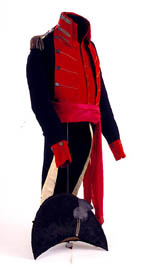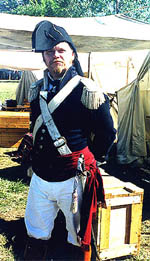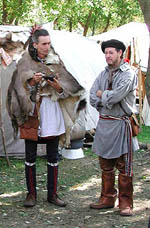
U.S. Militia coat, waistcoat, chappeau and sash

A General in the American Army
Combatants in the War
The Americans
The thirteen American colonies had rebelled against British rule in 1775. They were finally granted their independence in 1783. But they only gained control of certain parts of their territory in 1794. It was not until after Jay's Treaty was signed that the British finally left American soil. A number of the men fighting in the Western District were from Ohio and Kentucky. Freedom was very important to them, so they disliked the British who they felt did not respect their independence. Many of them were settled on traditional Native homelands. This had brought them into open conflict with many tribes, whom they often feared and hated.

U.S. Militia coat, waistcoat, chappeau and sash |

A General in the American Army |
The British
The British had gained control of North America from the French in 1761. At the time of the war, the colonists who were originally from Britain thought of themselves as British. They did not think of being "Canadian". The British saw themselves as the ruling, upper class and this attitude is often reflected in their writings. In the Western District, they had kept control of Detroit until 1796, when they finally retired to the Canadian side of the border.

British army uniforms in the War of 1812 |
The French-Canadians
The area around the Detroit River had been settled by the French starting in 1701. It had come under British control in 1761, but there was still a large population of French speaking people. They are often referred to as "Canadians" in the writings of the time.
| There were many different nations of Native people involved in the war. The Wyandot were a senior tribe in the Western district. Their main chief was Roundhead. Other war chiefs included Splitlog and Walk-in-the-Water. They had influence over what are called the "Lake Indians" and the "Wabash Indians." The Lake group consisted of the Ojibwa, the Ottawa, the Potawatomi and the Wyandot. The Wabash were the Miami, the Shawnee, the Delaware and the
Kickapoo. Tecumseh, the Shawnee chief, had been attempting to create a Native confederacy since 1805. When his brother, the Prophet, was defeated at Tippecanoe in 1811, Tecumseh brought his people north to ally with the British. After the capture of Mackinac, the fur trader Robert Dickson brought a number of Western Native groups to Amherstburg to join with Tecumseh and the other nations. These were of the Sauk, Fox, Menominee, Sioux and Winnebago nations. At the time of the war, people of European descent referred to the Natives as "Indians" and, consistent with the racial attitudes of that era, many considered them "uncivilized" and "savages." |

Re-enactors as Native ally and voyageur |

Tomahawk |